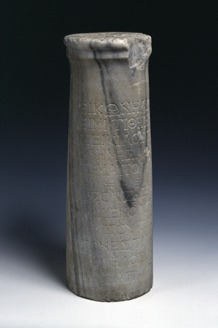用戶:だ*ぜ/塞基洛斯的墓誌銘

《塞基洛斯的墓誌銘》(希臘語:Επιτάφιος του Σείκιλου)是希臘化時代伊奧尼亞地區的歌曲,也是全世界現存最早的音樂作品。歌詞及歌曲以古希臘式樂譜記錄,在現今的土耳其艾登發掘出土。據判斷,此石柱的年代在公元前兩世紀到公元一世紀之間,而以在公元一世紀最為可能。[1][2]
在石柱上,用通用希臘文刻寫了:「我是一塊墓碑,一個標識,塞基洛斯將我安放在此處,作為不朽的紀念。」(Εἰκὼν ἡ λίθος εἰμί.Τίθησί με Σείκιλος ἔνθα μνήμης ἀθανάτου σῆμα πολυχρόνιον)
內容
[編輯]曲譜
[編輯]歌詞上方是(此處使用希臘語變音符號來標記)是用字母及符號標記的古希臘曲譜[3][4]:

在這個喪葬石碑的重建中,我們可以在文本的各行中註明持續時間的指示:
- ・:也稱為恥辱,表明時間很長;
- ⏝:鏈接組音符;
- ―:也稱為曲調-使音符的持續時間加倍;
- ⏗:tratt短劃線,也稱為triseme,使音符的持續時間重複三次。
據此,轉錄成現代樂譜,大致是:

銘文
[編輯]以下是在墓碑上發現的銘文的原始轉錄文字、通用希臘文字、現代希臘文羅馬轉錄版、英文譯文以及中文翻譯(不包括音譜符號):
| 古典希臘文 | 通用希臘語[註 1] | 拉丁化轉錄 | 英語譯文[5] | 中文譯文[註 2][6] |
|---|---|---|---|---|
| ΕΙΚΩΝ Η ΛΙΘΟΣ | Εἰκὼν ἡ λίθος | Eikōn hē lithos | I am a tombstone, | 我是一塊墓碑 |
| ΕΙΜΙ∙ΤΙΘΗΣΙ ΜΕ | εἰμί· τίθησί με | eimi; tithēsi me | an image. | 一個標識 |
| ΣΕΙΚΙΛΟΣ ΕΝΘΑ | Σείκιλος ἔνθα | Seikilos entha | Seikilos placed me here, | 塞基洛斯將我安放在此處 |
| ΜΝΗΜΗΣ ΑΘΑΝΑΤΟΥ | μνήμης ἀθανάτου | mnēmēs athanatou | as a long-lasting sign of deathless remembrance. | 作為不朽的紀念 |
| ΣΗΜΑ ΠΟΛΥΧΡΟΝΙΟΝ | σῆμα πολυχρόνιον. | sēma polychronion. | ||
| ΟΣΟΝ ΖΗΣ ΦΑΙΝΟΥ | Ὅσον ζῇς φαίνου | hóson zêis, phaínou | As long as you live, shine, | 既存之 當耀之 |
| ΜΗΔΕΝ ΟΛΩΣ ΣΥ ΛΥΠΟΥ | μηδὲν ὅλως σὺ λυποῦ | mēdèn hólōs sù lupoû | Let nothing grieve you beyond measure. | 無由生憂 |
| ΠΡΟΣ ΟΛΙ ΓΟΝ ΕΣΤΙ ΤΟ ΖΗΝ | πρὸς ὀλίγον ἐστὶ τὸ ζῆν | pròs olígon estì tò zên | For your life is short, | 生命存之轉瞬 |
| ΤΟ ΤΕΛΟΣ Ο ΧΡΟΝΟΣ ΑΠΑΙΤΕΙ | τὸ τέλος ὁ χρόνος ἀπαιτεῖ. | tò télos ho khrónos apaiteî. | and time will claim its toll. | 光陰終將主宰萬物 |
| ΣΕΙΚΙΛΟΣ ΕΥΤΕΡ |
猜測與推論
[編輯]
目前大約有50個希臘古典時代到羅馬時期的古代音樂作品。大多數都寫在莎草紙上,只有三個保存在石頭上。而其中兩個是來自德爾福阿波羅神殿的銘文碎片。
公元前127年,有題詞提到了兩位作曲家:雅典娜和萊茵紐斯。他們為合唱團表演創作音樂,所創作的文字和節點標誌都刻在雅典財政部的外牆上。石頭上的第三個成分是塞基洛斯專欄。儘管材料稀疏,但它證明在公元前200年的希臘世界中,存在一個節點系統。或者,可能在公元前300年代可能有兩個節點系統:一個用於樂器音樂,一個用於聲樂,但它們可能只用於專業作曲家和合唱團領導者。其他人通過傾聽他們來學習音樂。沒有任何跡象表明希臘節點系統存活到中世紀。但在拜占庭時代,早期文藝復興時期的符號已被添加到希臘系統中。
日期
[編輯]塞基洛斯的墓誌銘的歷史可以追溯到公元前200年左右到公元100年左右,而公元1世紀是最可能的猜測[1]。而據一位權威人士指出,在古文字銘刻方式的基礎上[註 3],可以保險估計是於公元前一世紀[7]。此外,與127/8和149/50 AD時期的銘文進行比較亦可以確定它是公元二世紀的時期[8]。
單詞
[編輯]石柱的最後兩個單詞是(中括號中是後人的猜測[9] ):
Σείκιλος Εὐτέρ [πῃ], Seikilos Euter [pei],
意思是說「塞基洛斯獻給艾戴佩」,也即根據這種猜測,墓碑可能是塞基洛斯為妻子艾戴佩所立。[10]
第二種可能是:
Σείκιλος Εὐτέρ [που], Seikilos Euter [pou],
意思是說「尤特普的塞基洛斯」,即「塞基洛斯,尤特普之子」。[4][9][11]
發現與展覽
[編輯]
墓誌銘是由威廉·米謝爾·瑞姆賽爵士於1883年在艾登省附近的一個小鎮艾登發現的。
有文獻指,大約在1919年至1922年的希土戰爭結束時,石碑於1922年在士麥那丟失,後被重新發現[12]。根據另一個消息來源,在艾登省旁邊的鐵路建設期間首次發現的石碑,首先由建築公司的Edward Purser導演擁有,Ramsay在那裏發現並發佈了該石碑。
大約在1893年,由於它「底部被打破,底座被鋸成直線,因此它可以作為Purser夫人的花盆的基座」;這導致了一行文字的丟失,即當石碑現在直立時,磨削已經消除了銘文的最後一行。石碑接下來傳給愛德華·普爾瑟的女婿楊先生,後者將其保存在士麥那的布卡。直到希臘人失敗之前,它一直保存在士麥那;而在戰爭期間,其安全保存於荷蘭領事。領事的女婿後來經過君士坦丁堡和斯德哥爾摩將其帶到了海牙。直到1966年,它被丹麥國家博物館(丹麥語:Nationalmuseet)的古董部收購,石碑的現在位置位於哥本哈根的博物館(庫存號:14897)。[13]
參考內容
[編輯]註釋
[編輯]文獻
[編輯]- ^ 1.0 1.1 Landels, John G. Music in Ancient Greece and Rome. 1999: page 252.
- ^ Winnington-Ingram, R. P. Ancient Greek Music: A Survey. Music & Letters. 1929, 10 (4): 326–345.
- ^ Mathiesen, Thomas J. Apollo's Lyre: Greek Music and Music Theory in Antiquity and the Middle Ages. 1999: page 149.
- ^ 4.0 4.1 Pöhlmann, Egert; West, Martin L. (編). Documents of Ancient Greek Music: The Extant Melodies and Fragments. 2001: page 88.
- ^ This 2,000-Year-Old Song Is The Oldest In History — Hear It For Yourself. All That's Interesting. 2018-07-11 [2018-11-05] (美國英語).
- ^ For the translation of τέλος, cf. Landels 1999,252.
- ^ Mathiesen, Thomas J. Greek Music and Music Theory in Antiquity and the Middle Ages. Apollo's Lyre: Greek Music and Music Theory in Antiquity and the Middle Ages. U of Nebraska Press. 1999. ISBN 0803230796 (英語).
- ^ Pohlmann, Professor of Classical Philology Egert. Documents of Ancient Greek Music: The Extant Melodies and Fragments. Clarendon Press. 2001. ISBN 9780198152231 (英語).
- ^ 9.0 9.1 Pöhlmann, Egert; West, Martin L. (編). Documents of Ancient Greek Music: The Extant Melodies and Fragments. 2001: page 91.
- ^ Randel, Don Michael (編). Seikilos epitaph. The Harvard Dictionary of Music: Fourth Edition. 2003: page 767.
- ^ Pilch, John J. Flights of the Soul: Visions, Heavenly Journeys, and Peak Experiences in the Biblical World. 2011: page 79.
- ^ Landels, John G. Music in Ancient Greece and Rome. 1999: page 252.
- ^ Pöhlmann, Egert; West, Martin L. (編). Documents of Ancient Greek Music: The Extant Melodies and Fragments. 2001: page 88.
書籍
[編輯]- Cosgrove, Charles H., and Mary C. Meyer. 2006. "Melody and Word Accent Relationships in Ancient Greek Musical Documents: The Pitch Height Rule". Journal of Hellenic Studies 126:68–81.
- Cosgrove, Charles. 2011. An Ancient Christian Hymn with Musical Notation: Papyrus Oxyrhynchus 1786: Text and Commentary. Heidelberg: Mohr Siebeck Verlag. ISBN 3161509234
- D'Angour, Armand. 2018. "The Song of Seikilos". In: Tom Phillips and Armand D'Angour (eds). Music, Text, and Culture in Ancient Greece. Oxford University Press ISBN 9780198794462, pp. 64-72.
- Devine, A.M., and Laurence D. Stephens. 1994. The Prosody of Greek Speech. Oxford and New York: Oxford University Press. ISBN 978-0-19-508546-4, ISBN 978-0-19-537335-6.
- Hagel, Stefan. 2008. "Ancient Greek Rhythm: The Bellermann Exercises". Quaderni Urbinati di Cultura Classica, New Series, 88, no. 1:125–38.
- Landels, John G. 1999. Music in Ancient Greece and Rome. London and New York: Routledge. ISBN 9780415167765 (cloth); ISBN 9780415248433 (pbk); ISBN 9780203042847 (ebook).
- Lynch, Tosca. 2019. "Rhythmics". In Lynch, T. and Rocconi, E. (eds.), A Companion to Ancient Greek and Roman Music, Hoboken: Wiley-Blackwell.
- Mathiesen, Thomas J. 1981. "New Fragments of Ancient Greek Music". Music Theory Spectrum 7:159–80.
- Mathiesen, Thomas J. 1985. "Rhythm and Meter in Ancient Greek Music". Acta Musicologica, Vol. 53, Fasc. 1, pp. 14-32. doi:10.1525/mts.1985.7.1.02a00090
- Mathiesen, Thomas J. 1999. Apollo's Lyre: Greek Music and Music Theory in Antiquity and the Middle Ages. Lincoln: University of Nebraska Press.
- Palisca, Claude V. 2006. Music and Ideas in the Sixteenth and Seventeenth Centuries. Studies in the History of Music Theory and Literature 1. University of Illinois Press. ISBN 9780252031564.
- Pöhlmann, Egert, and Martin Litchfield West. 2001. Documents of Ancient Greek Music: The Extant Melodies and Fragments. Oxford and New York: Oxford University Press. ISBN 978-0-19-815223-1.
- Probert, Philomen. 2003. A New Short Guide the Accentuation of Ancient Greek. Bristol Classical Press.
- Randel, Don Michael (ed.). 2003. "Seikilos Epitaph". The Harvard Dictionary of Music, fourth edition. Cambridge, MA: Belknap Press for Harvard University Press.
- Solomon, Jon D. 1986. "The Seikilos Inscription: A Theoretical Analysis". American Journal of Philology 107 (Winter): 455–79.
- Winnington-Ingram, Reginald P. 1929. "Ancient Greek Music: A Survey". Music & Letters 10, No. 4 (October): 326–45.
[[Category:古希臘藝術]] [[Category:音樂史]]
